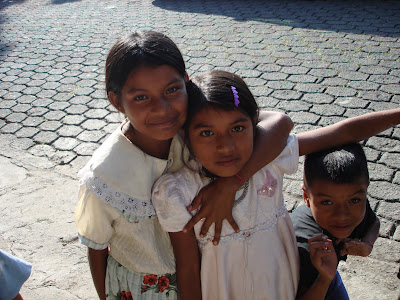Agua
The Kitchen
Mt. Fuego letting off steam
We also took a tour of Finca Filadelfia, a local coffee plantation.
These are unripe coffe beans. When they are ready to pick they turn red.
Coffee seedlings. They stay here for one year. There are two types of coffee plants, arabica and robusto. Arabica beans are the best for coffee, but arabica plants only live 3-5 years. Robusto, on the other hand, is not that good for coffee, but the plants live 30-35 years. One of the factors that shortens the lifespan of an arabica plant is a worm that lives in the ground and eats the roots. Also, arabica roots are more delicate and do not penetrate deep into the soil. In order to fool the worms and give the arabica plant stronger roots, they take the lower stem of a robusto plant and the up plant part of the arabica and splice them together. The bean that is produced is still 100% arabica. Only women are allowed to do this process. Apparently the pH level of a woman's skin is better suited to the plant.
This is a bean with the "cherry" removed.
Random mountain pic
This starts the processing of the beans. After being picked they are poured in this apparatus with water. The bad beans float to the top. The good beans go to the bottom.
The bad beans are skimmed from the top and the good beans are sent down this channel for further separation. Slats are installed in grooves in the channel. The better beans stay to the bottom while the not so good beans flow over and through.
After the beans are separate, they have to have the cherry removed. This is an antiquated machine for that process.
The is the modern machine for removing the cherry.
Good beans.
Pre-roasted bean samples.
When it comes time, the plantation hires women (again for pH level) to pick out the bad beans as they come down these conveyor belts. They are sorted once, then the beans that passed are sent down the next belt to be sorted again and then a third time.
These are the roasting machines.
Guatemala exports 85% of its coffee. It is exported pre-roast.
At Casa Shalom, Bob and I have been trying to install a pressure switch on a water pump to keep it from overflowing the cistern into a house on the property.
This is where the water comes in from the city of San Lucas.
This is where the pressure switch will go.
The water is pumped from this cistern the main cistern up the hill. Bob turned the pump off, but there is an elevation difference of 50ft., so there is a lot of pressure in the line.
The old setup. Bob is removing the old switch.
The pressure switch.
If installed by itself, the pressure switch would cycle the pump on every time the water level dropped down just a few inches to alleviate the pressure. What we are doing is installing a control box that will receive the kill signal from the pressure switch. That will cut power to the whole system until this green button is pushed.
We got it all hooked up and it did not work like we hoped. We visited the store where we purchased the equipment. Their electricians helped us to understand how to hook it all up. We took it all back to Casa Shalom and hooked it all back up...and this time...our push button blew. It would appear that this is the only push button like this in all of Guatemala. So we are working on a work around.
Tuesday we bought more food for the Rio Bravo meal program for the children. A team from Florida came down with some shoes for the Rio Bravo children. We took the food and shoes to Rio Bravo Wednesday morning. The children love having their pictures taken. They beg us to take their pictures.






































































